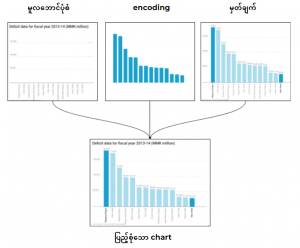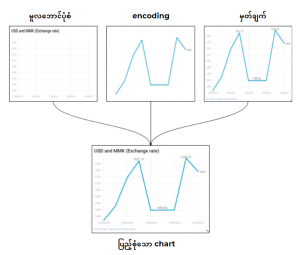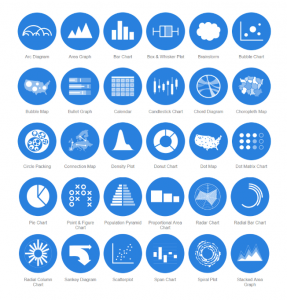ဒေတာ visualization သင်တန်းမှရသောသင်ခန်းစာများ
Open Development Myanmar အနေနဲ့ ဒေတာအချက်အလက်တွေကို လူအများနားလည်အောင် မြင်သာသောပုံစံနဲ့ ပြသပေးလျက်ရှိပါတယ်။ သဘောကတော့ ဒေတာ တွေကို ပုံနဲ့ပြဖို့ ဆိုတာ ကျွန်တော်တို့ရဲ့ နေ့စဥ်အလုပ်မှာ အရေးကြီးတဲ့အရာ တစ်ခုဖြစ်နေပါတယ်။ ၂၀၁၈ ဇွန်လတုန်းက the Knight Center for Journalism အဖွဲ့အစည်းကအင်တာနက်ပေါ်မှာ ဒေတာ visualization သင်တန်း တစ်ခု ပေးခဲ့ပြီး ဒေတာတွေကိုပုံစံအမျိုးမျိုးနဲ့ဖော်ပြရာမှာ ထိထိရောက်ရောက်နဲ့ ဆွဲဆောင်နိုင်အောင် နည်းလမ်းကောင်းတွေ သင်ကြားပေးထားပါတယ်။ မိမိတို့ရဲ့နေ့စဥ်အလုပ်မှာ ဒေတာတွေကိုပုံနဲ့ပြနေရသူတွေအတွက် ရည်ရွယ်ထားတဲ့သင်တန်းဖြစ်ပြီး ဒေတာအခြေခံ သတင်းရေးအတတ်ပညာမှာ အရေးပါထင်ရှားတဲ့ ပါမောက္ခတစ်ဦးဖြစ်တဲ့ Alberto Cairo ကသင်ပြပေးထားပါတယ်။ အဲဒီသင်တန်းကနေလေ့လာမိတဲ့ သင်ခန်းစာနှစ်ခုကို ဒီ blog ကနေ ဝေမျှပေးသွားပါမယ်။
၁. visualization ရဲ့ အစိတ်အပိုင်း ၃ခု
ဒေတာအစုတွေကို ပုံတွေနဲ့ ဖော်ပြရာမှာ (၁). မူလဘောင်ပုံစံ (၂). Encoding ပုံစံ နဲ့ (၃). မှတ်ချက် ဆိုပြီး အပိုင်း ၃ပိုင်း ခွဲထားပါတယ်။ ဒါကြောင့် မူရင်းဘောင်တစ်ခု၊ အချက်အလက်ကိုတိတိကျကျပြပေးမယ့် encoding နဲ့၊ သင့်လျော်တဲ့ မှတ်သားချက်တွေပေါင်းလိုက်မယ်ဆိုရင် သင့်ရဲ့ပုံဟာ လုံးဝပြည့်စုံနေမှာဖြစ်ပါတယ်။ ဒီ၃ခုစလုံးကိုအသေးစိတ်ထပ်ပြောပြပေးပါမယ်။
ပထမဆုံးတစ်ခုဖြစ်တဲ့ frameworkမှာ chartတွေကို မှန်မှန်ကန်ကန်တိုင်းတာပြနိုင်ဖို့ စကေးတွေပါဝင်ပါတယ်။ ဒုတိယအနေနဲ့ chart မှာပါရမယ့်အကြောင်းအရာကို မြင်သာအောင်အတိအကျ ပြပေးဖို့လိုပြီး အဲဒီလိုပြတာကို encoding လို့ ခေါ်ပါတယ်။ နောက်ဆုံးတစ်ခုဖြစ်တဲ့ မှတ်ချက်ကတော့ chart ထဲမှာရှိတဲ့ အကြောင်းအရာတွေကို အမှတ်အသားတွေနဲ့ ဖော်ပြပေးဖို့ ဖြစ်ပါတယ်။ ဒါတွေအားလုံးပေါင်းလိုက်ရင်တော့ chart ကောင်းကောင်းတစ်ခုရမှာဖြစ်ပြီး အောက်မှာဥပမာပုံလေးတွေ နဲ့ ပြပေးထားပါတယ်။
ပုံ ၁ . visualization အစိတ်အပိုင်းများ ကို bar chart သုံးပြီးပြထားပုံ
( Source : budget.omi.org )
အပေါ်ပုံက ၂၀၁၃-၁၄ ဘဏ္ဍာနှစ် အတွက် မြန်မာနိုင်ငံရဲ့ ဘတ်ဂျက်လိုငွေကို bar chart ပုံစံနဲ့ တိုင်း၊ပြည်နယ်အလိုက်ပြထားခြင်း ဖြစ်ပြီး ပုံအပြည့်အစုံမရခင် မူလဘောင်ပုံစံ၊ encoding နဲ့ မှတ်ချက်ဆိုပြီး ၃ပိုင်းခွဲ ပြထားပါတယ်။ မှတ်ချက်ပုံမှာဆိုရင်တော့ ဘတ်ဂျက်လိုငွေ အများဆုံးဖြစ်တဲ့ မကွေးတိုင်းဒေသကြီး (ကျပ်သန်းပေါင်း ၁၈၄,၀၀၀)နဲ့ လိုငွေအနည်းဆုံးဖြစ်တဲ့ မွန်ပြည်နယ် (ကျပ်သန်းပေါင်း ၂၈,၂၇၈) တို့ကို အဓိက ဖော်ပြထားပါတယ်။
ပုံ ၂ . visualization အစိတ်အပိုင်းများ ကို line chart သုံးပြီးပြထားပုံ
( Source : mataf.net )
ပုံ ၂ ကတော့ သြဂုတ်လလယ်တုန်းက ဒေါ်လာစျေးအတက်အကျကို သမားရိုးကျ line chart နဲ့ ပြပေးထားတဲ့ပုံဖြစ်ပါတယ်။ မှတ်ချက်ပုံကိုကြည့်လိုက်မယ်ဆိုရင် သြဂုတ်လ ၁၆ရက်နေ့က တစ်ဒေါ်လာကို မြန်မာငွေ ၁၅၂၇ကျပ်အထိ မြင့်တက်ခဲ့ပြီး ၁၇ရက်နေ့မှာ ၁၄၉၀ကျပ်ကို ပြန်ကျသွားပါတယ်။ ၂၀ရက်နေ့မှာတော့ ၁၅၂၉ကျပ်အထိ တစ်ဟုန်ထိုး ပြန်တက်ခဲ့တာကို ပုံပါအတိုင်းတွေ့မြင်နိုင်ပါတယ်။
၂. encoding ရဲ့ အရေးပါဝင်မှု
ဒေတာတွေကိုပုံစံအမျိုးမျိုးနဲ့ပြရာမှာ အစိတ်အပိုင်းသုံးခုထဲကတစ်ခုဖြစ်တဲ့ encoding ဟာ မြင်သာတဲ့ပုံစံနဲ့ပြပေးရတဲ့ နေရာဖြစ်လို့ သုံးခုထဲမှာ အရေးအကြီးဆုံးဖြစ်ပါတယ်။ ပထမဆုံးအနေနဲ့ ဒေတာပြဖို့အတွက် သင့်လျော်တဲ့ encoding ကိုရွေးချယ်ရမှာဖြစ်လို့ တခါတရံ လိုအပ်တဲ့ဒေတာတွေရနေပေမယ့် ဘယ်chartကိုသုံးပြီးပြမလဲဆို တာကိုမသိဘဲဖြစ်တတ်ပါတယ်။ Bar chart နဲ့ line chart ကိုသုံးပြီးပြမလား၊ pie chart ကိုပဲသုံးပြီးပြရမလား စဥ်းစားရကြပ်လာရင်တော့ စိတ်မပူပါနဲ့။ အသင့်တော်ဆုံး chart ပုံစံကို ရွေးမိ ဖို့ကူညီပေးနိုင်တဲ့ နည်းလမ်းတွေအများကြီး ရှိနေလို့ပါပဲ။
Encodingတွေကိုရွေးချယ်ရာမှာ ‘ရည်ရွယ်ချက်’ ပေါ်မူတည်ပြီး ရွေးချယ်ရမှာ ဖြစ်ပါတယ်။ လူတွေကိုဘာပြပေးချင်တာလဲ၊ graphကဘာအတွက်လဲ၊ အချိန်ကိုလိုက်ပြီးပြောင်းလဲချက်တွေကို နှိုင်းယှဥ်ပြချင်တာလား စတာတွေကို အမြဲထည့်သွင်းစဥ်းစားပေးရပါမယ်။
ဒီရည်ရွယ်ချက်တွေပေါ်လိုက်ပြီး ကိုယ်သုံးမယ့် chart ပုံစံကိုစဥ်းစားနိုင်တဲ့အပြင် လုံးဝမတူတဲ့ chart ပုံစံမျိုးကိုလည်း ပြောင်းလဲရွေးချယ်နိုင်ပါတယ်။ ဥပမာပြောရရင် တစ်ခုနဲ့တစ်ခုနှိုင်းယှဥ်ပြချင်တယ်ဆိုရင် bar chart ကိုရွေးချယ်သင့်ပြီး အရာဝတ္ထုတစ်ခုလုံးရဲ့ အစိတ်အပိုင်းတွေကိုပဲ ယှဥ်ပြပေးချင်ရင်တော့ pie chart ကအကောင်းဆုံးဖြစ်ပါတယ်။ mapကတော့ ပထဝီဝင်ဆိုင်ရာဧရိယာပေါ်က ဒေတာတွေကိုပြသရာမှာ အသုံးပြုသင့်ဆုံး အမျိုးအစားဖြစ်ပါတယ်။
ပုံ ၃ . The data visualization catalogue (Source : datavizcatalogue.com)
ဘယ်chart တွေသုံးရမလဲဆိုတာကို ရွေးချယ်ရာမှာကူညီပေးမယ့် အင်တာနက်ပေါ်ကအခမဲ့ သုံးလို့ရတဲ့အရင်းအမြစ် တွေလည်းအများကြီးရှိပါတယ်။ ဥပမာအနေနဲ့ The data visualization catalogue ကတော့ ကွဲပြားတဲ့ရည်ရွယ်ချက်တွေပေါ်လိုက်ပြီး သုံးလို့ရမယ့် အမျိုးမျိုးသော encodingနည်းလမ်းတွေကို ပြထားပါတယ်။
ဒါတွေကတော့ encoding နည်းလမ်းများရွေးချယ်ရာမှာ အသုံးဝင်မယ့် linkလေးတွေ ဖြစ်ပါတယ်။
- Financial Times Visual Vocabulary
- Dataviz project.com
- The graphic continuum
- The Art & Science of Communicating Data
- From Data to Viz
- Ann K. Emery ရဲ့ မရှိမဖြစ် chart ပုံစံများ
- Datalabs ရဲ့ အသုံးများတဲ့ ဒေတာ visualization ပုံစံ ၁၅မျိုး
- Medium ရဲ့ ပိုမိုအသုံးပြုသင့်တဲ့ ဒေတာ visualization ပုံစံ ၇မျိုး
အခုထိပြောခဲ့တာတွေကတော့ ပြန်ပြီးshareပေးချင်တဲ့ သင်ခန်းစာနှစ်ခုပဲဖြစ်ပါတယ်။ ကောင်းမွန်သော ဒေတာများနဲ့ လူအများရဲ့ အာရုံစူးစိုက်မှုသာရနိုင်မယ်ဆိုရင် သင့်ရဲ့visualization တွေဟာပြီးပြည့်စုံနေမှာဖြစ်ပါတယ်။ သင့်လျော်တဲ့ encoding ကိုရွေးချယ်ပြီး ဒေတာတွေကို ပုံစံမှန်မှန်နဲ့ ပြသဖို့လည်း မမေ့ကြပါနဲ့နော်။




